Best Tower Fans to Beat the Next Heatwave [2024 Roundup]
Tower fans are a modern variation of the traditional pedestal fan that features a sleek, narrow, vertical design. Tower fans deliver a steady stream of gentle air rather than the buffeting associated with a regular fan. The best tower fans produce a strong, far-reaching, yet quiet flow of air while filtering out pollutants.

Tower fans generate a cool breeze using an impeller fan located in their base, despite their “no-blade” appearance. The impeller fan in the base pushes cool air up the vertical tower at pressure. Valves along the length of the tower release and direct this air to circulate your room in one smooth stream.
Tower fans have five advantages over traditional pedestal fans. Firstly, tower fans produce a steadier airflow that is less noticeable and disruptive. Secondly, tower fans take up less space because of their slender design. Thirdly, tower fans are more aesthetically pleasing and will fit in beautifully in well-designed homes. Fourthly, tower fans generally have more advanced features and controls – some fans even connect to your smart speaker. Finally, tower fans often have a heating element, so you’re able to use them as fans or space heaters.
Tower fans have two disadvantages compared to traditional fans. Firstly, tower fans’ movement is more limited, so it’s hard to direct them to a specific area or person. Secondly, tower fans tend to cost more than regular fans. However, the price varies on whether you opt for a premium brand or a model with advanced features.
Below are three of the most sought-after tower fan brands in the UK.
- Dyson: Dyson were the first brand to make bladeless fans, and their “air multiplier” design remains iconic. The “air multiplier” references the aerodynamic ability of the Dyson tower fans’ hollow loop shape to generate a volume of 15x the airflow created by its interior fan. The Dyson loop design has the shape of an aeroplane’s wing – an airfoil shape – that pulls additional air through the fan. Dyson fans are much more expensive than tower fans produced by other brands, but offer superior airflow, WiFi connectivity and air purification, whilst many models have both heating and cooling capabilities.
- Dimplex: Dimplex are a more affordable alternative to Dyson, but they still produce advanced and stylish tower fans. Dimplex specialise in cooling, heating, and air purification and have been in the market for over 70 years.
- Honeywell: Honeywell represent a great value-for-money brand in the climate management space and make high-quality tower fans at a reasonable price.
Oscillation and remote control are two features that generally drive up the price tag and make a tower fan more desirable. Oscillating tower fans offer an impressive turning radius that allows them to circulate air evenly around an entire room. Likewise, many of the best tower fans on the market include a remote that lets you adjust your tower fan’s settings without getting up.
A tower fan typically costs £0.01 – £0.04 to run for an hour and £1.8 – £9 to run for 6 hours a day for a month. Most tower fans will consume 20 – 50 watts of electricity an hour, depending on the model. That translates to £0.01 – £0.04 to run for an hour at current UK electricity rates of £0.34p – £0.70 per kilowatt hour.
There are plenty of suitable alternatives to tower fans on the market if you think a tower fan won’t suit your use case. One common alternative is ceiling fans, which effectively ventilate an entire room. However, ceiling fans are more expensive to install. Cheaper options include desk fans, which fit on a work desk, and pedestal fans, which are the closest to a tower fan in configuration and function.
Dyson tower fans
Dyson tower fans are some of the most expensive and advanced fans on the market. Most Dyson tower fans come with the characteristic hollow loop design, air purification and WiFi connectivity features, and some models double as heaters and coolers.
Dyson was the first brand to pioneer the “air multiplier” design, which a lot of other tower fan manufacturers have since copied. Dyson tower fans have an impeller fan in their base that helps to generate a smooth stream of air and cut down on the buffeting waves of air associated with traditional pedestal fans. The unique airfoil design generates 15x the airflow you would expect from its internal fan by drawing in more air.
Below are the four best Dyson tower fans.
- Dyson TP04
- Dyson Ph01
- Dyson Hot + Cool
- Dyson AM07
We review the four aforementioned Dyson fan models below.
Dyson TP04 Tower Fan
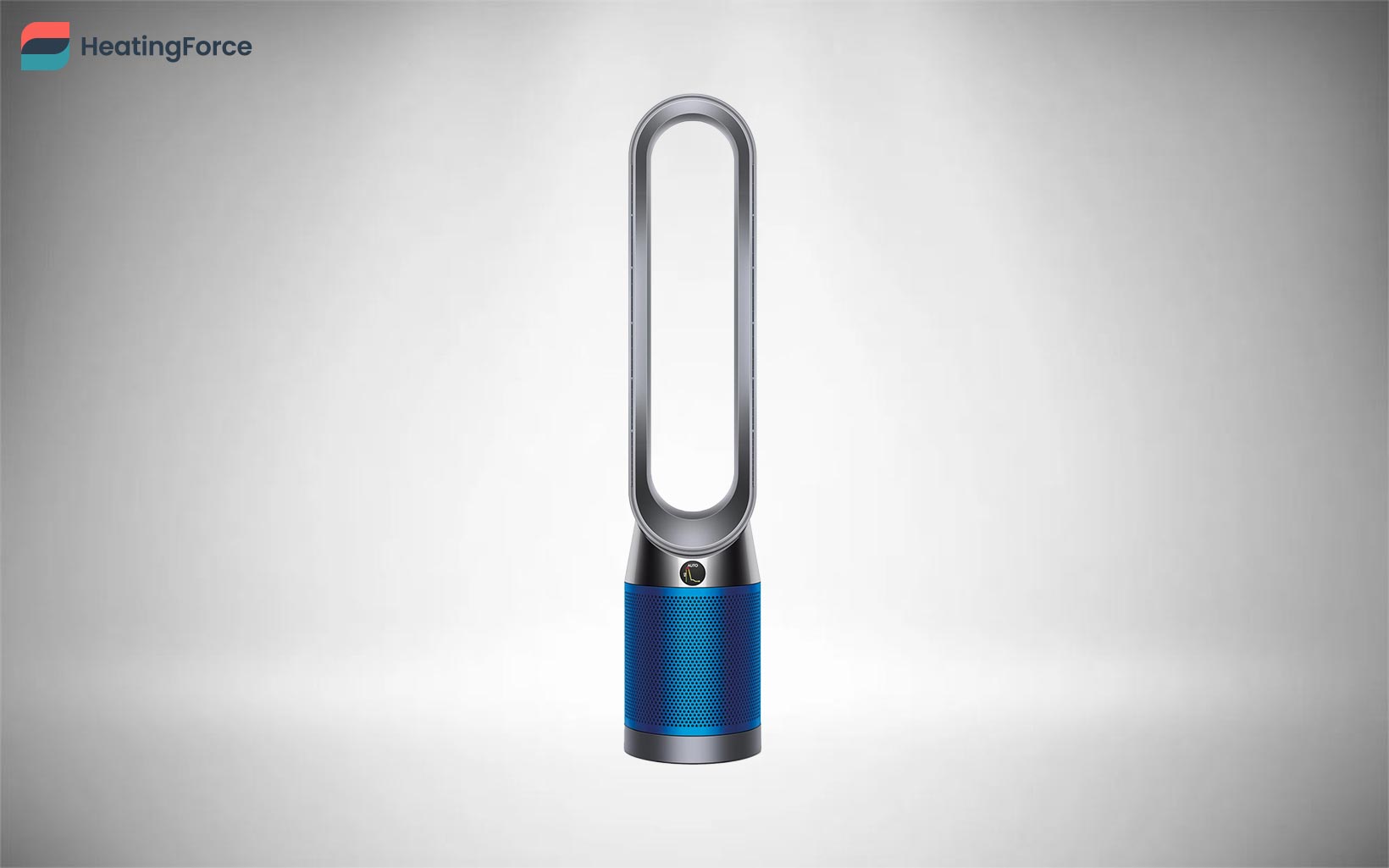
The Dyson TP04 is a medium-sized tower fan that comes in at the lower end of Dyson’s price range while retaining many of the brand’s advanced filtration features.
A major draw of the Dyson TP04 is its ability to sense and report PM2.5, PM10, VOC, and NO2 pollutant levels in real time. A 360-degree sealed glass HEPA filter uses activated carbon filters and removes 99.5% of pollutants as small as .1 microns.
You’re able to monitor the air quality level and filtration activities via the MyDyson smartphone app, which gives you full control over the fan’s functions. Alternatively, you’re able to control the TP04 from the couch or the comfort of your bed using the Dyson remote control. Likewise,
The 56 decibels of noise generated by the TP04 is around the volume of a household refrigerator, which could be offputting for some. However, the TP04 comes with a night-time mode that reduces noise levels during your sleep.
The below table offers a guide to the costs involved in buying and running a Dyson TP04 tower fan.
| Dyson TP04 Costs | |
|---|---|
| Purchase cost | £400-£500 |
| Power consumption | 0.22kwh |
| Running cost per hour | £0.07-£0.15 |
| Running cost per month* | £13.46 – £27.72 |
*Monthly usage costs are based on 6 hours of daily use.
Dyson PH01 Tower Fan
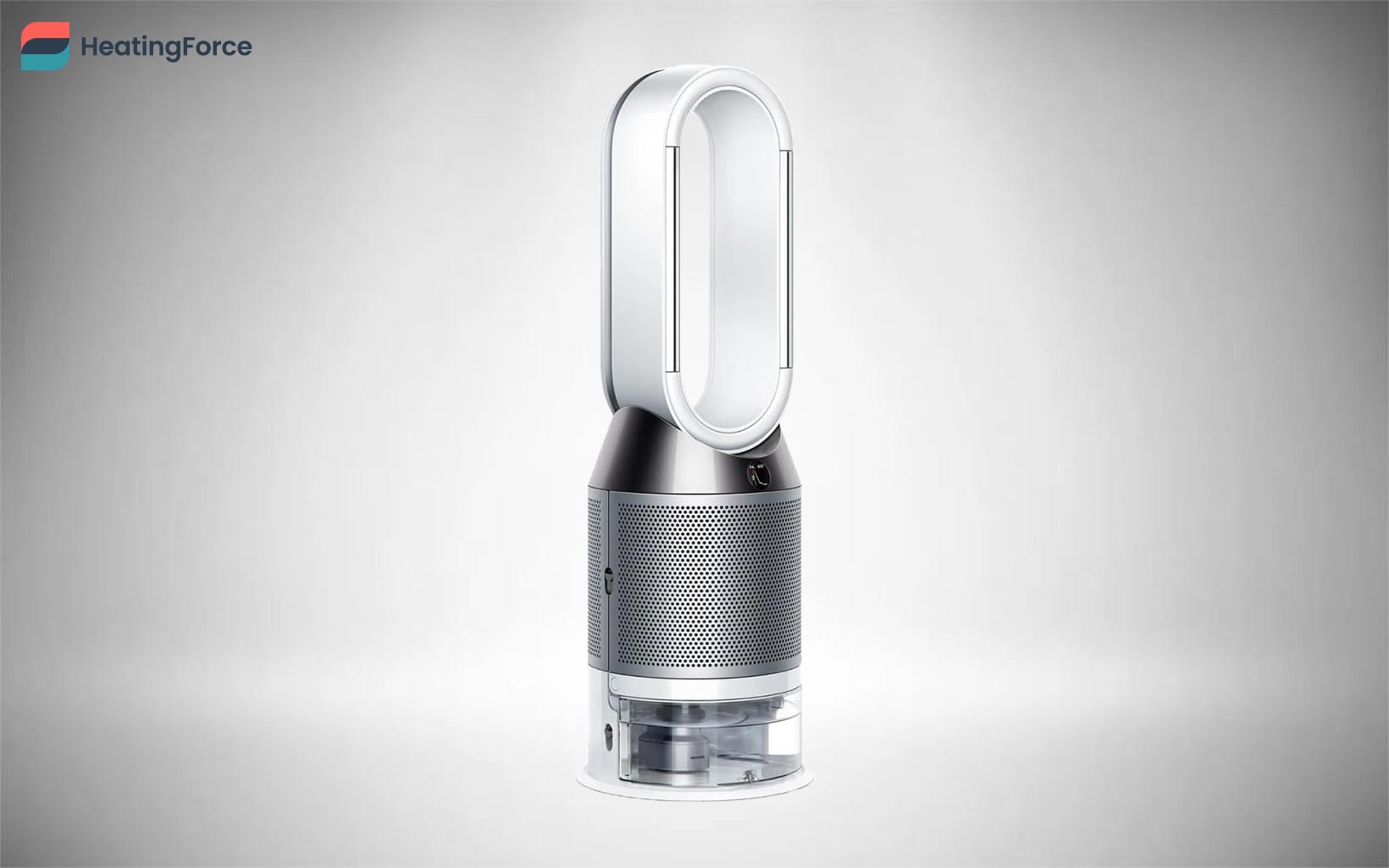
The Dyson PH01 is a medium-sized 3-in-1 air purifier, humidifier, and tower fan. An impressive amount of functionality comes at a significant cost with the Dyson PH01’s high price point.
The Dyson PH01 has an intelligent sensor that automatically detects airborne particles and monitors your home’s temperature and humidity levels. A deep clean filter clears pollutants from the fan’s water storage, so the unit only distributes clean water in the air.
You connect your PH01 to your phone via the MyDyson app to monitor your air’s humidity and receive real-time air quality reports. The MyDyson app sends you notifications when you need to change your unit’s filter.
Dyson’s unique “Air Multiplier” allows the PH01 to produce 84 gallons of airflow a second, with an option to optimise your home’s humidity balance. The powerful airflow and humidifying functions generate about 50 decibels of noise when the fan is in operation, which is similar to the volume of a quiet refrigerator.
The table below provides an overview of the purchase and running costs of a Dyson PH01 tower fan.
| Dyson PH01 | |
|---|---|
| Purchase cost | £850-£950 |
| Power consumption | 0.04kwh |
| Running cost per hour | £0.01-£0.03 |
| Running cost per month* | £2.45 – £5.04 |
*Monthly usage costs are based on 6 hours of daily use.
Dyson AM09 Hot + Cool Fan
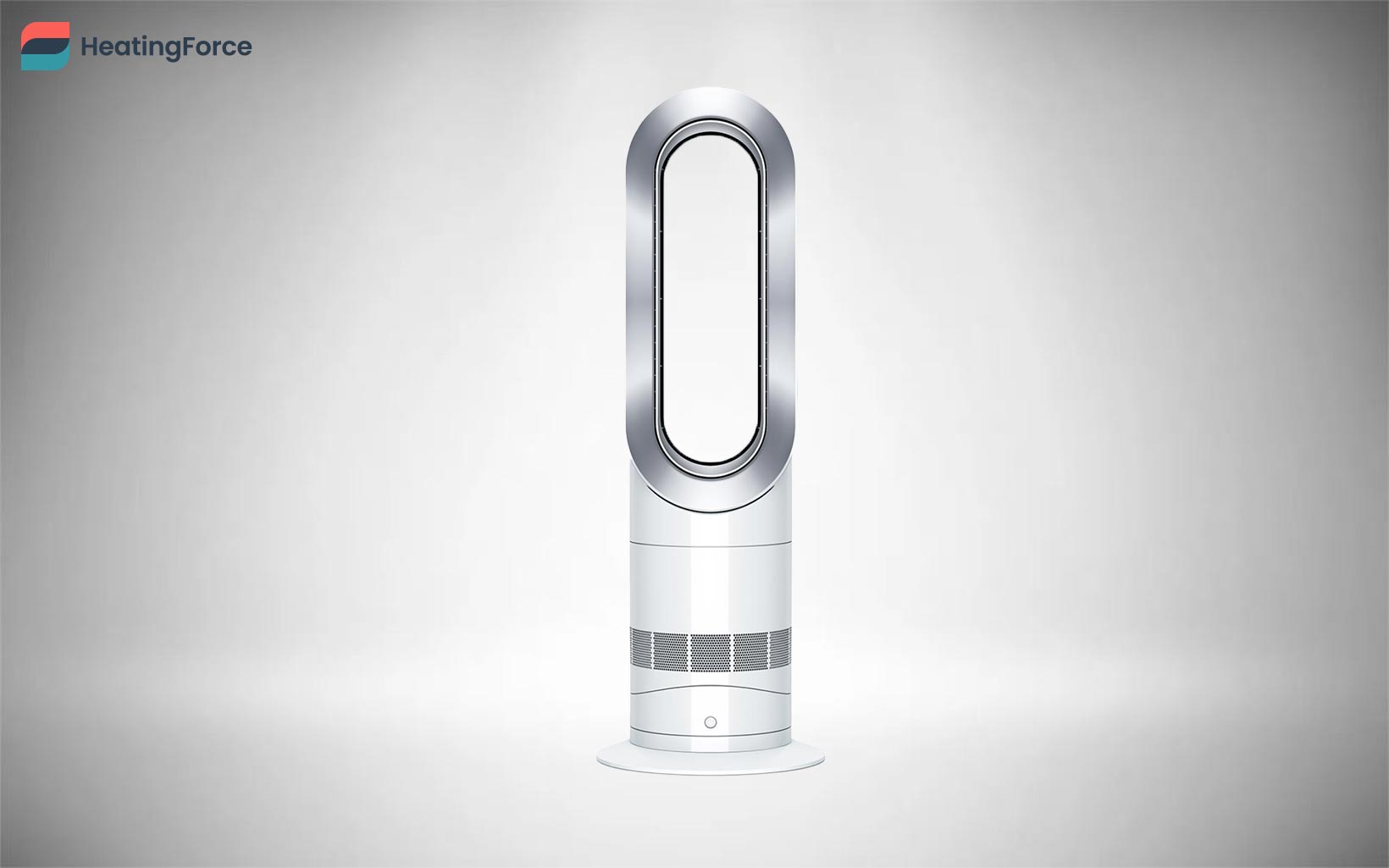
The Dyson Hot + Cool Fan is a compact-sized, premium tower fan that incorporates heating and cooling capabilities to keep your home at the perfect temperature.
The AM09 comes at a much lower price than other Dyson products, although it’s still higher than that of any non-Dyson product on this list. The Hot + Cool Fan does lack some of the advanced wifi integrations and air purification properties of some of Dyson’s more expensive offerings.
Dyson’s Air Multiplier technology delivers a smooth stream of air without the use of blades. The absence of blades not only reduces any buffeting wind but also limits the risk of injury from fast blades.
The Dyson AM09 comes with precise heating and cooling capabilities to keep your home at a comfortable temperature. A Dyson AM09’s settings are easily controlled by using either the remote control or the unit’s sleep timer settings. The Dyson Hot + Cool Fan’s heating element is calibrated never to exceed 392F, which is the burning point of dust, to cut down on unpleasant smells.
The below table outlines the approximate costs involved in buying and operating a Dyson AM09 Hot + Cool tower fan.
| Dyson AM09 Hot + Cool | |
|---|---|
| Purchase cost | £300-£400 |
| Power consumption | 0.03kwh |
| Running cost per hour | £0.01-£0.02 |
| Running cost per month* | £1.83 – £3.78 |
*Monthly usage costs are based on 6 hours of daily use.
Dyson AM07 Tower Fan
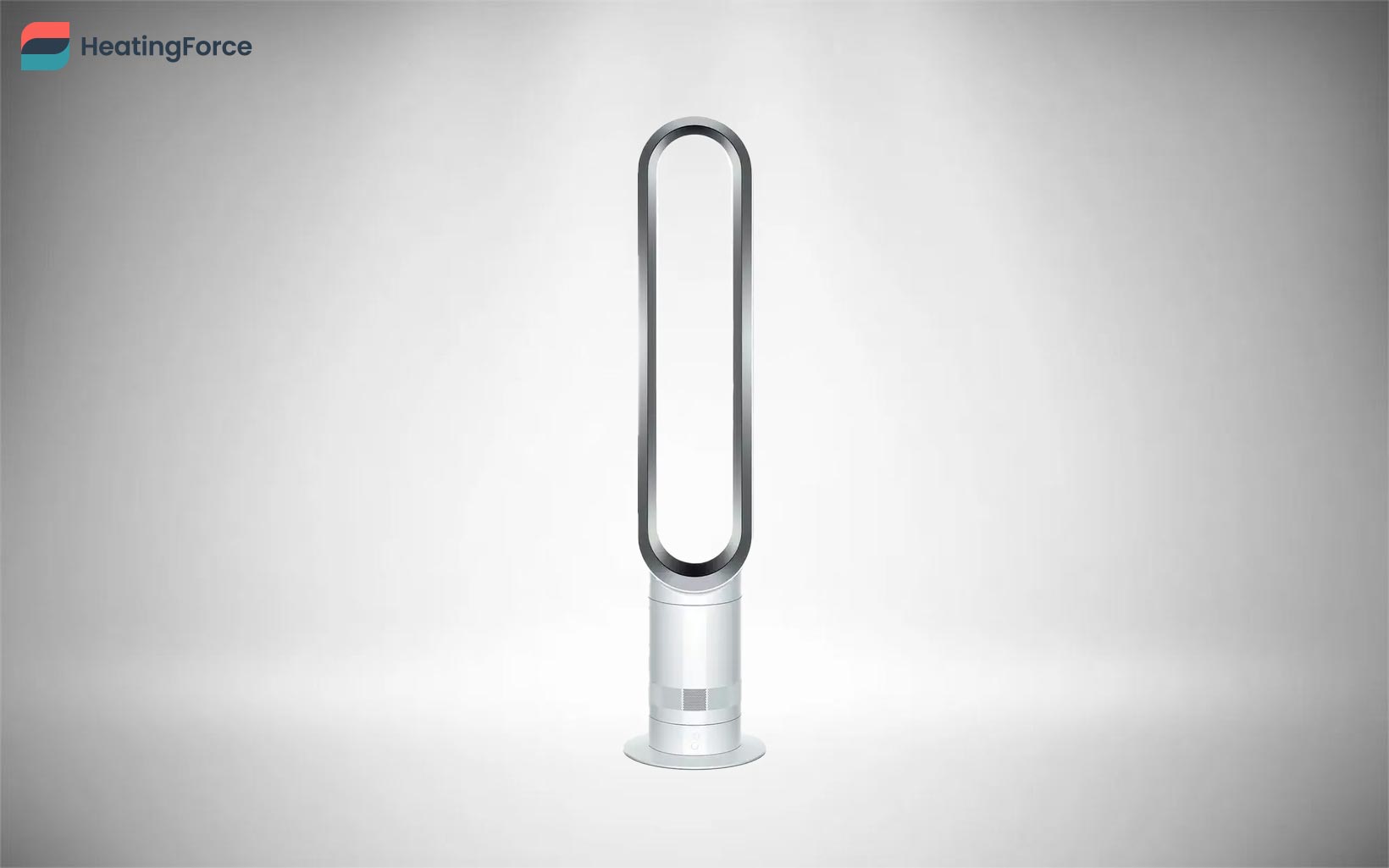
The Dyson AM07 is a medium-sized tower fan with fewer features and a lower price point than most other Dyson fans. The AM07 retains the core bladeless tower fan design that characterizes all Dyson fans and comes with a sleep timer, remote control, and an easy-to-clean design. However, the AM07 has no heating or cooling capabilities and does not purify your home’s air, unlike other Dyson models.
The Dyson AM07 uses “Air Multiplier” technology to produce 500 litres per second of airflow. The Air Multiplier design does not use blades to push air around your home, cutting down on buffeting airwaves and reducing the risk of injury. The AM07 generates 50 decibels of noise, which is similar to the noise emissions produced by other Dyson fans.
The below table provides a guide on what it costs to buy and run a Dyson AM07 tower fan.
| Dyson AM07 | |
|---|---|
| Purchase cost | £300-£400 |
| Power consumption | 0.05kWh |
| Running cost per hour | £0.02-£0.04 |
| Running cost per month* | £3.42 – £7.06 |
*Monthly usage costs are based on 6 hours of daily use.
Dimplex tower fans
Dimplex is a premium fan manufacturer that makes high-quality, stylish, and feature-packed tower fans. Dimplex tower fans are a budget-friendly alternative to their Dyson counterparts. However, the lower price point does not indicate poor quality.
The two Dimplex tower fans currently available on the market are as follows.
- Dimplex Ion Fresh
- Dimplex Mont Blanc
We review these two Dimplex tower fans below.
Dimplex Ion Fresh Cooling Tower
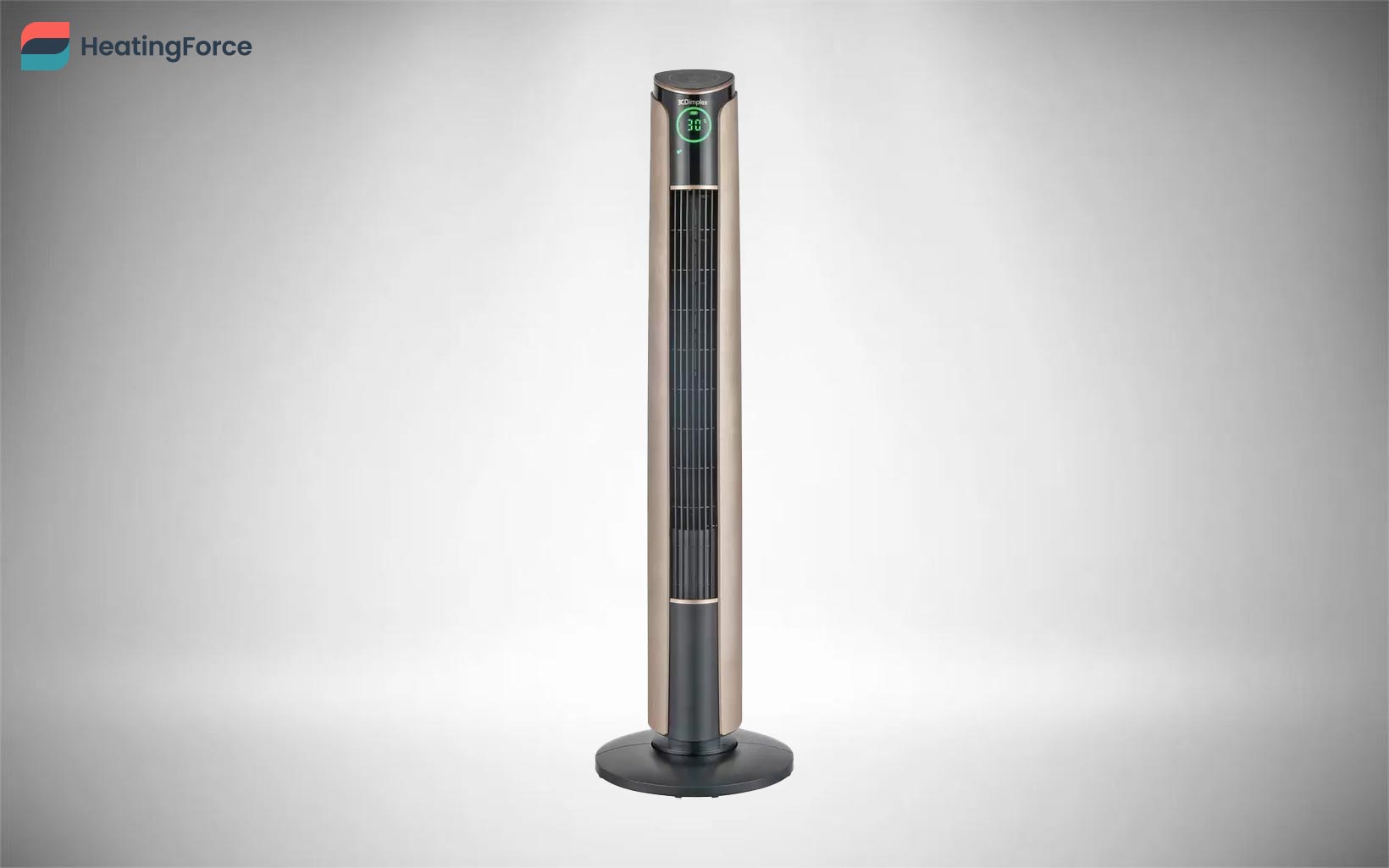
The Dimplex Ion Fresh Cooling Tower is a medium-sized fan that combines ionising air purification with a sleek tower design and a reasonable price.
The core feature of the Dimplex Ion Fresh cooling tower is its ioniser mode. The ioniser mode produces negative ions that attract positive ions in your home’s air, creating a fresher environment. Particles acquire a positive charge as they float around your home, so ionisation is an effective way of clearing particles from your home’s air. Ionizers trialled by the National Health Service (NHS) in a hospital ward reduced influenza infection rates to near zero.
Other essential features of the Dimplex Ion Fresh include remote control, a 3-speed fan, and the following three ventilation settings.
- Natural setting: The “Natural” setting mimics a breezy day.
- Sleep setting: “Sleep” is a gentler setting to keep you cool while you sleep.
- Easy setting: The “Easy” setting slows down the fan speed for three hours.
The Dimplex Ion Fresh produces 50 decibels of noise, which is similar to the noise level of a Dyson fan.
The below table gives an overview of the financial impact of buying and running a Dimplex Ion Fresh Cooling tower fan.
| Dimplex Ion Fresh Cooling Tower | |
|---|---|
| Purchase cost | £80-£130 |
| Power consumption | 0.04kwh |
| Running cost per hour | £0.01-£0.03 |
| Running cost per month* | £2.75 – £5.67 |
*Monthly usage costs are based on 6 hours of daily use.
Dimplex DXMBCF Mont Blanc Tower Fan
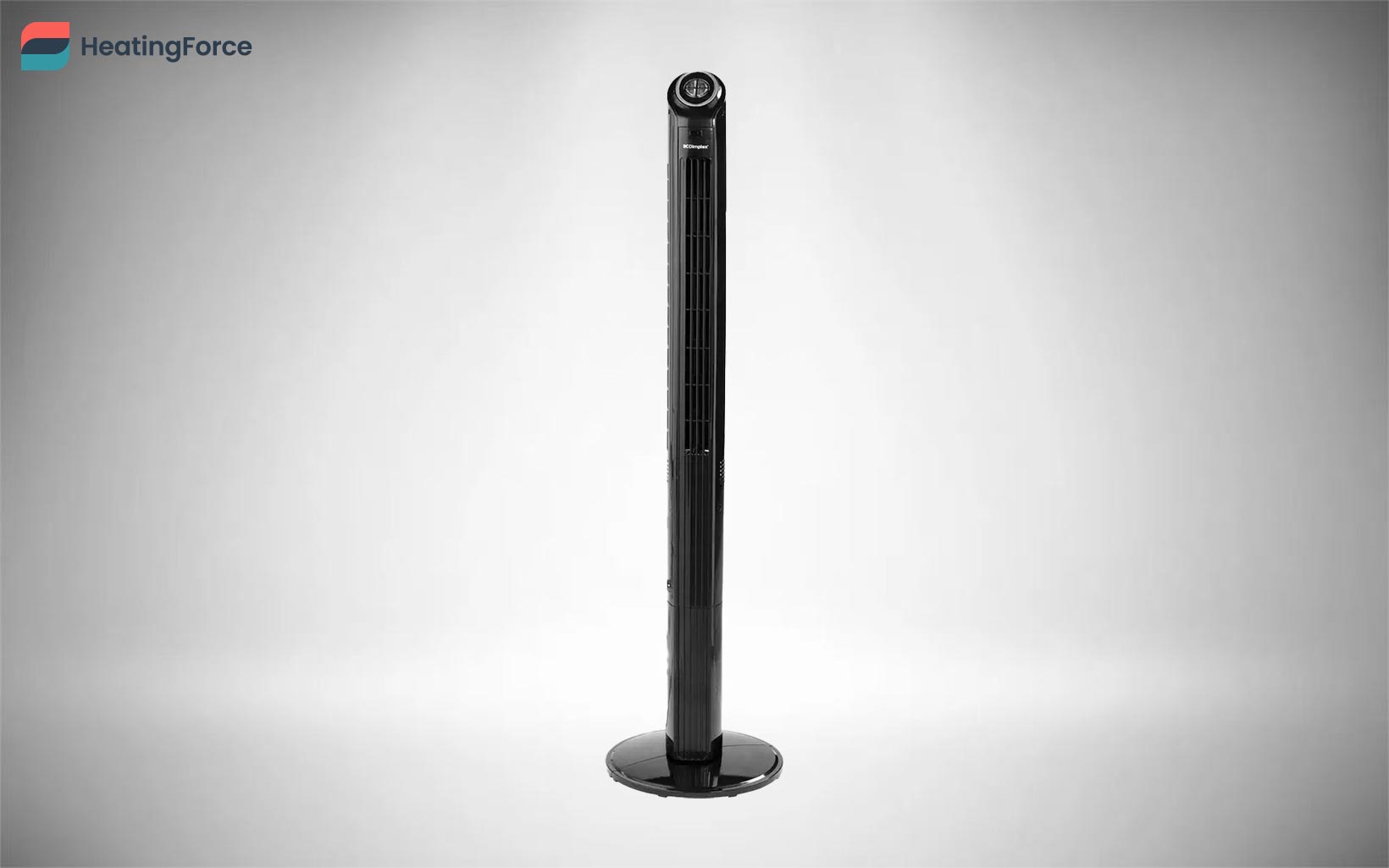
The Dimplex Mont Blanc is a large tower fan with a tall, slender profile, and world-class cooling, but no air purification capabilities. The Mont Blanc is a more affordable Dimplex offering than the Ion Fresh.
The Dimplex Mont Blanc has three speed settings, an LED display, and a remote control. The Mont Blanc comes with a 3-year guarantee once your register the device with Dimplex.
The Dimplex Mont Blanc produces 50 decibels of noise, which is standard for modern tower fans.
The below table outlines the expense of running a Dimplex DXMBCF Mont Blanc tower fan.
| Dimplex DXMBCF Mont Blanc | |
|---|---|
| Purchase cost | £60-£100 |
| Power consumption | 0.04kwh |
| Running cost per hour | £0.01-£0.03 |
| Running cost per month* | £2.75 – £5.67 |
*Monthly usage costs are based on 6 hours of daily use.
Honeywell tower fans
A multi-niche home comfort manufacturer, Honeywell is a budget-friendly tower fan brand that produces consistent and reliable fans.
The three Honeywell models on the market are as follows.
- Honeywell QuietSet
- Honeywell TurboForce
- Honeywell Comfort Control
Below is our review of the three Honeywell tower fan models.
Honeywell QuietSet HYF290BE Tower Fan
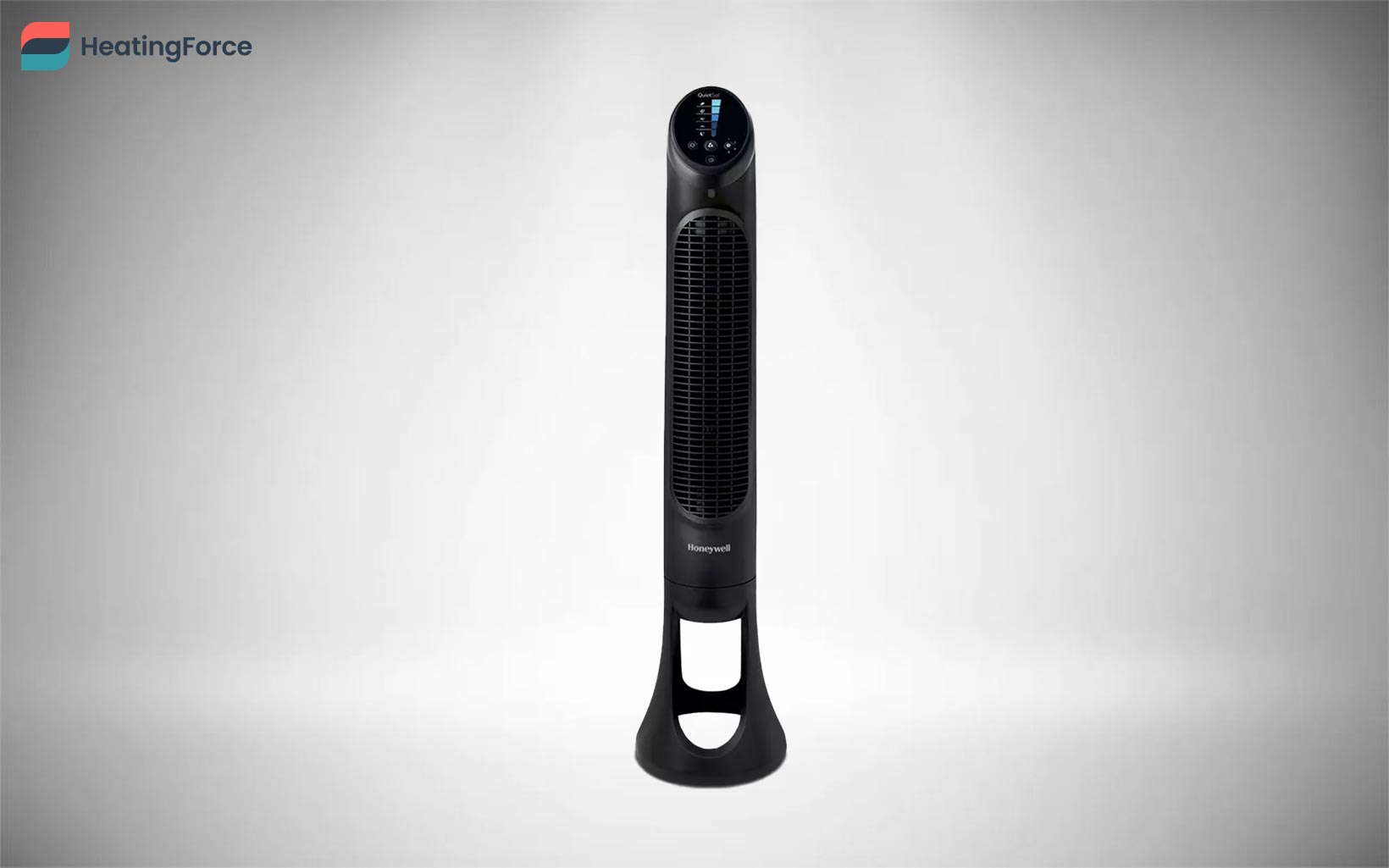
The Honeywell QuietSet is a small but powerful mid-market fan that comes with a range of light, timer, and speed settings but doesn’t purify the air.
The Honeywell QuietSet comes with 8 speed settings, which are adjustable from the QuietSet’s control panel or the included remote controller. The QuietSet comes with a 1, 2, 4, and 8-hour shut-off timer for automated operation.
Auto-dimming on the QuietSet’s control panel after 15 seconds reduces distracting light. You are also able to set the dimming to 5 different lighting selections – 100%, 75%, 50%, 25%, and off. The QuietSet’s dimming features make the fan suitable for use at night.
The Honeywell QuietSet produces 63 decibels of noise, which is roughly equivalent to the volume of an air conditioner or dishwasher, and noisier than most tower fans.
The below table offers a guide to the costs of purchasing and operating a Honeywell QuietSet HYF290BE tower fan.
| Honeywell QuietSet HYF290BE | |
|---|---|
| Purchase cost | £80-£120 |
| Power consumption | 0.03kwh |
| Running cost per hour | £0.01-£0.02 |
| Running cost per month* | £1.84 – £3.78 |
*Monthly usage costs are based on 6 hours of daily use.
Honeywell TurboForce HYF500 Tower Fan

The Honeywell TurboForce is an affordable yet powerful device that uses the ventilating power of two fans to give you ultimate control over your cooling experience. The two-fan design means the TurboForce acts as an effective personal cooler or circulates a cool breeze around an entire room.
Two independently controlled fans housed in the TurboForce’s main body set the unit apart from its competitors, which typically rely on a single fan. The top fan is designed for whole-room cooling and rotates 90°. By contrast, the bottom fan is designed for targetted, personal cooling, but oscillates to reach wider spaces. Each fan comes with three speed settings for a total of six, and TurboForce’s intuitive dial controls make it easy to adjust settings.
The inclusion of two separate fans affords you greater control of the TurboForce’s cooling intensity. The cool breeze from the TurboForce is felt from 40 feet away at its highest setting.
The Honeywell TurboForce produces 63 decibels of noise, which makes the fan slightly noisier than its Dyson and Dimplex counterparts.
The below table offers an approximation of the costs linked to buying and running a Honeywell TurboForce HYF500 tower fan.
| Honeywell TurboForce HYF500 | |
|---|---|
| Purchase cost | £40-£60 |
| Power consumption | 0.03kwh |
| Running cost per hour | £0.01-£0.02 |
| Running cost per month* | £1.84 – £3.78 |
*Monthly usage costs are based on 6 hours of daily use.
Honeywell Comfort Control Tower Fan
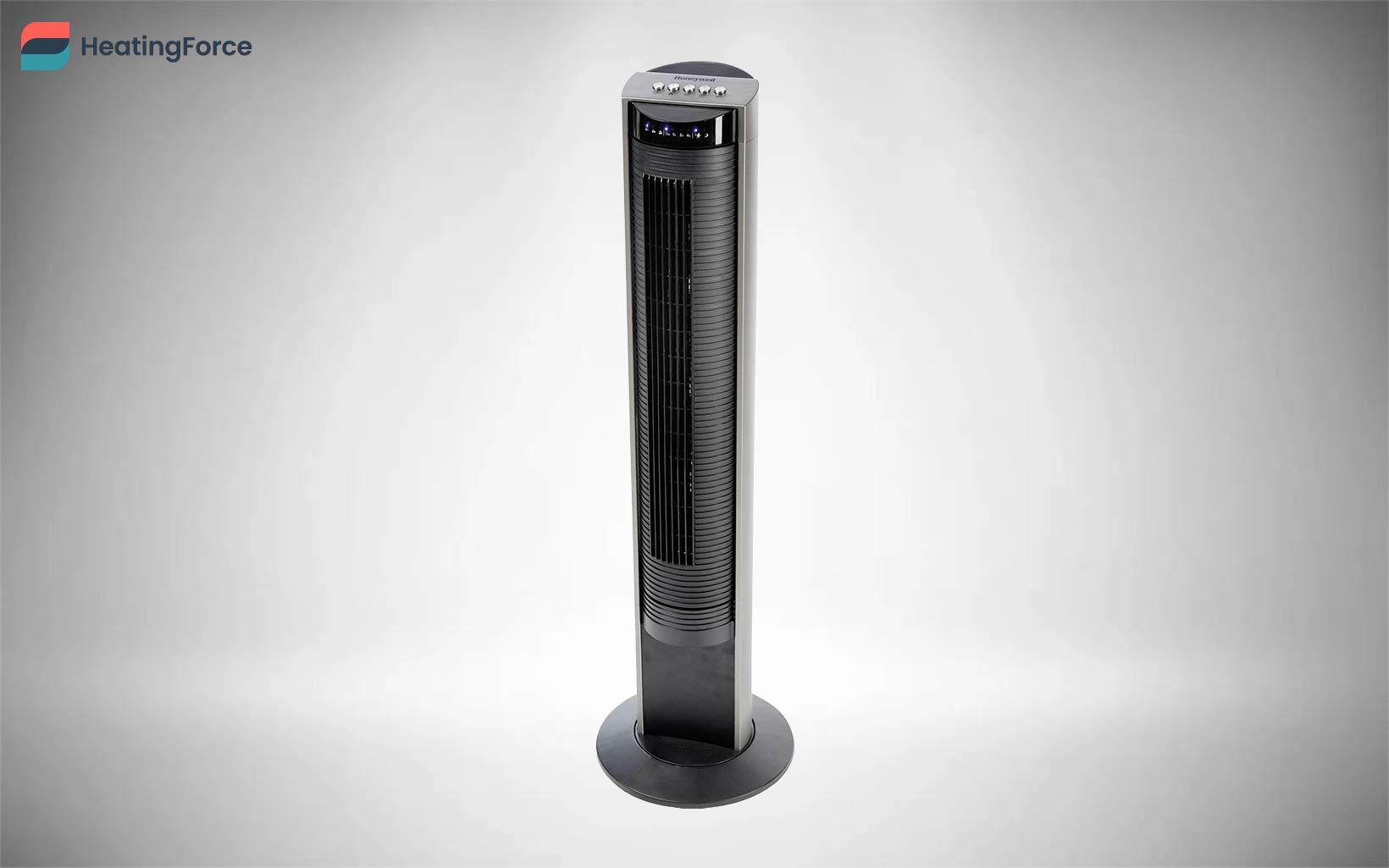
The Honeywell Comfort Control is a small, light mid-market tower fan designed with portability in mind.
Three speed settings and an oscillating body make the Comfort Control effective at ventilating rooms of different sizes and configurations. Meanwhile, Comfort Control’s 1, 2, 4, and 8-hour auto-off timer allows you to go to sleep and trust that the unit won’t run all night. The Honeywell Comfort Control produces 52 decibels of noise, which is around the volume of a running refrigerator, and quieter than other Honeywell fans on this list.
Honeywell designed the Comfort Control not to take up too much space and be easily moved between different locations. A small body with measurements of 40 cm x 12 cm x 12 cm that weighs just 4.5 kg is easy to move and store. The Comfort Control comes with a recessed carry handle for easy transport.
An LED display and touch button controls make adjusting your fan’s settings a breeze.
The below table offers an outline of the cost of buying and using a Honeywell Comfort Control tower fan.
| Honeywell Comfort Control | |
|---|---|
| Purchase cost | £70-£100 |
| Power consumption | 0.04kwh |
| Running cost per hour | £0.01-£0.03 |
| Running cost per month* | £2.45 – £5.04 |
*Monthly usage costs are based on 6 hours of daily use.
Oscillating tower fans
Oscillating tower fans are able to rotate around their base to circulate air around a room. Consider investing in an oscillating tower fan if you want to cool a larger space full of occupants, such as an office. The three best oscillating tower fans are as follows.
- Igenix DF0030
- Bonaire Oscillating Tower Fan
- Kuyal Oscillating Tower Fan
Igenix DF0030BL Tower Fan
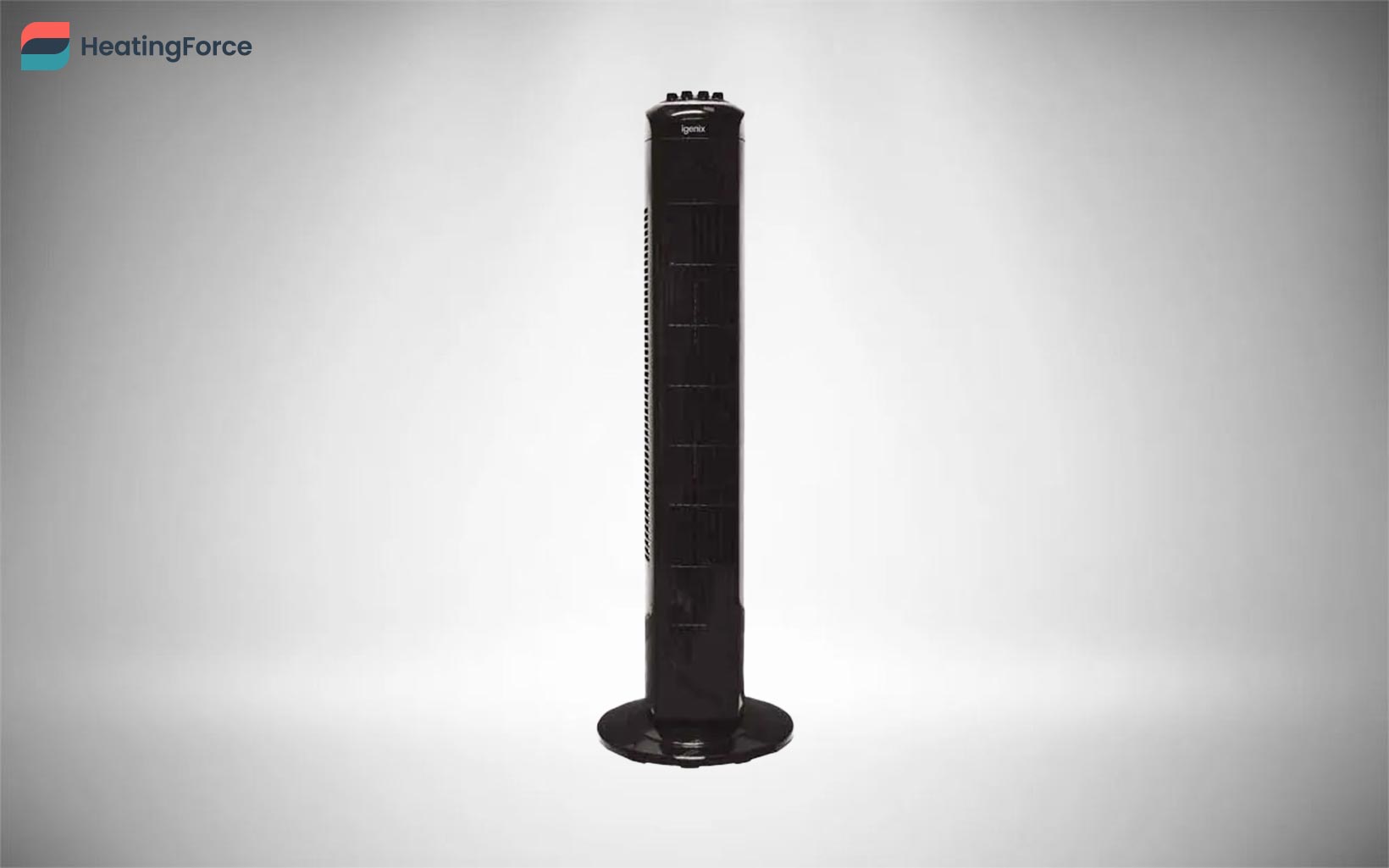
The Igenix DF0030BL is a compact, low-cost tower fan that delivers decent airflow and a few handy features, but is rather noisy and does not have a night mode function.
This tower fan from Igenix comes with three fan speed settings, all of which are quite powerful considering the low price point of the unit.
The 120-minute programmable timer gives you some control over the fan at night. However, note that the DF0030BL is a bit noisy, operating at 74dB when at full speed. 74 decibels is quite high compared to similar tower fans, which generally have an average noise level of 50 dB. Sadly, there is no night mode on this fan, so you have to be OK with a good deal of noise if you plan to sleep with the unit on.
The below table offers an overview of the purchase and operating costs for an Igenix DF0030BL tower fan.
| Igenix DF0030BL | |
|---|---|
| Purchase cost | £25-£40 |
| Power consumption | 0.04kwh |
| Running cost per hour | £0.01-£0.03 |
| Running cost per month* | £2.75 – £5.67 |
*Monthly usage costs are based on 6 hours of daily use.
Bionaire Oscillating Tower Fan
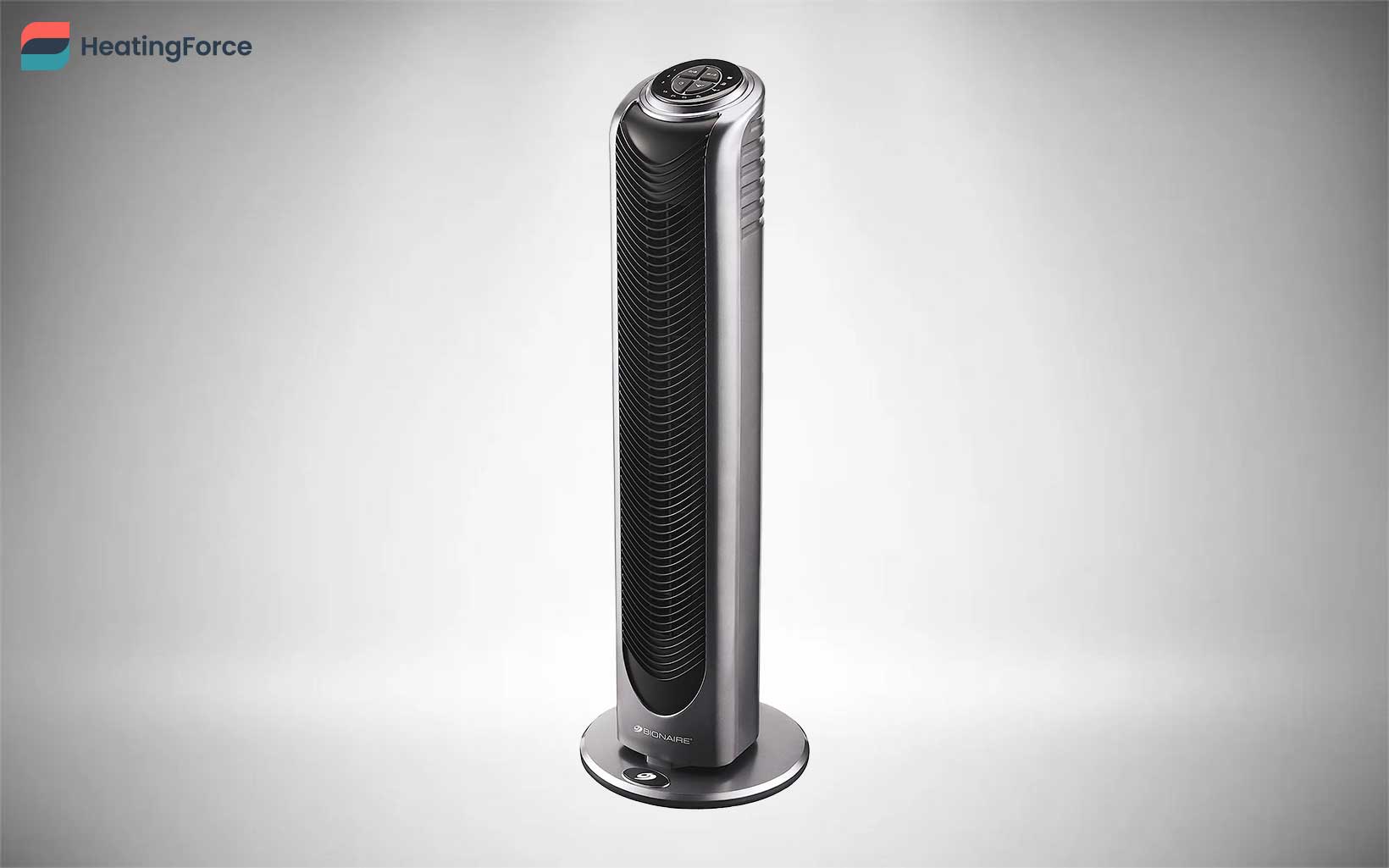
The Bonaire Oscillating Tower Fan is a stylish and affordable tower fan that fits easily into small spaces. The Bonaire’s silver finish and black accents fit in with the decor of any room.
The Bionaire Tower Fan has 3-speed settings and the ability to oscillate to ensure constant airflow throughout your home. A non-disruptive “sleep” function improves your sleep quality, and there’s even a “breeze” function that emulates the pattern of natural breezes.
The fan comes with a remote control, an LED display, and a timer that automatically switches your tower fan off at 1, 2, 4, and 8-hour intervals.
We recommend the Bonaire if you live in a small apartment, as the unit measures just 29.1 cm x 5.5 cm x 5.5 cm and weighs 3.54 kg. The Bionaire produces 46 decibels of noise, which is around the volume of a quiet space, such as a library.
The table below provides a guide to the costs involved in buying and running a Bionaire Oscillating tower fan.
| Bionaire Oscillating Tower Fan | |
|---|---|
| Purchase cost | £30-£50 |
| Power consumption | 0.05kwh |
| Running cost per hour | £0.01-£0.03 |
| Running cost per month* | £3.06 – £6.30 |
*Monthly usage costs are based on 6 hours of daily use.
Kuyal Oscillating Tower Fan

The Kuyal Oscillating Tower Fan is a well-built, medium-sized tower fan filled with settings to help you customize its operation.
One advantage of the Kuyal Tower fan is its durability. Kuyal made the unit from a durable ABS plastic that reduces the risk of breaking your fan and a carry handle that makes it easier to move from room to room.
The Kuyal Tower comes with a timer that is programmable in thirty-minute increments for a period of up to 7 hours and 30 minutes to shut off your fan automatically.
The Kuyal Tower fan has the following three wind mode settings that adjust the rhythm of its airflow.
- Normal: The “Normal” setting produces the same type of airflow you’d expect from any tower fan.
- Nature: The “Nature” setting mimics a natural breeze.
- Sleep: The “Sleep” setting reduces fan noise to help you sleep better.
The below table provides an overview of the costs of buying and using a Kuyal Oscillating tower fan.
| Kuyal Oscillating Tower Fan | |
|---|---|
| Purchase cost | £40-£60 |
| Power consumption | 0.05kwh |
| Running cost per hour | £0.01-£0.03 |
| Running cost per month* | £3.06 – £6.30 |
*Monthly usage costs are based on 6 hours of daily use.
Tower fans with remote control
Tower fans with remote control allow you to adjust your fan’s settings from the sofa or bed. Many tower fans on the market today come with remote controls included in the price. The five best tower fans with a remote are as follows.
- Princess Smart Wifi Connected Tower Fan
- VonHaus Tower Fan
- Belaco Tower Fan
- Netta Tower Fan
- Dreo One Nomad Tower Fan
Princess Smart WiFi-Connected Tower Fan

The Princess Smart Wifi Connected Tower Fan is a premium tower fan that offers smart speaker, smartphone, and Amazon Alexa integration.
The Princess Smart WiFi Connected Tower Fan comes with three airflow settings and a timer function. You are able to change the airflow settings and set the timer in the HomeWizard Climate app. The timer lets you program your fan to shut off after 1 to 8 hours, which is handy if you plan to sleep with the fan on. There’s a sleep setting that reduces the fan’s noise when activated.
The Princess is a large tower fan, measuring 105 cm x 33.5 cm x 33.5 cm and weighing 5.68 kg. The Princess produces 55 decibels of noise, which is around the volume of a normal conversation.
The below table offers an approximation of the costs involved in purchasing and operating a Princess Smart WiFi-Connected tower fan.
| Princess Smart WiFi-Connected | |
|---|---|
| Purchase cost | £90-£110 |
| Power consumption | 0.05kwh |
| Running cost per hour | £0.01-£0.03 |
| Running cost per month* | £3.06 – £6.30 |
*Monthly usage costs are based on 6 hours of daily use.
VonHaus Tower Fan
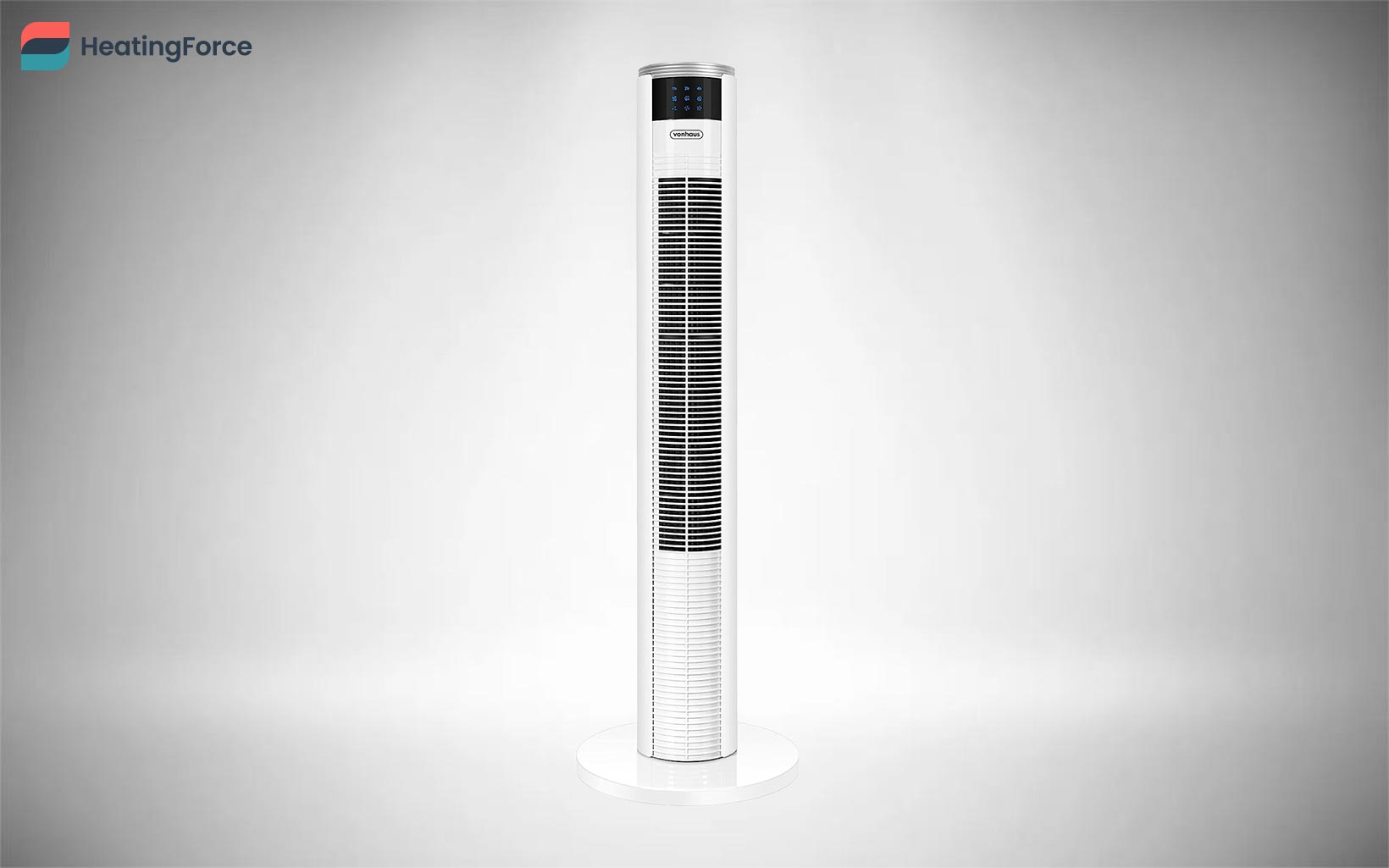
The VonHaus Tower Fan is a practical and affordable tower fan that comes with a remote control and is backed by a manufacturer’s warranty.
VonHaus’ features include a 7-hour timer function, three speed settings, and a remote control that lets you adjust those settings from anywhere in the room.
VonHaus backs their tower fan with a 2-year manufacturer warranty, which shows their confidence in their product.
The size and weight of the VonHaus are unremarkable, at 87 cm x 28 cm x 28 cm, and 3.35 kg. Similarly, the VonHaus produces a typical 54 decibels of noise, which is around the volume of a normal conversation.
The below table offers a guide to the costs linked with buying and using the VonHaus tower fan.
| VonHaus Tower Fan | |
|---|---|
| Purchase cost | £50-£70 |
| Power consumption | 0.06kwh |
| Running cost per hour | £0.02-£0.04 |
| Running cost per month* | £3.67 – £7.56 |
*Monthly usage costs are based on 6 hours of daily use.
Belaco Tower Fan
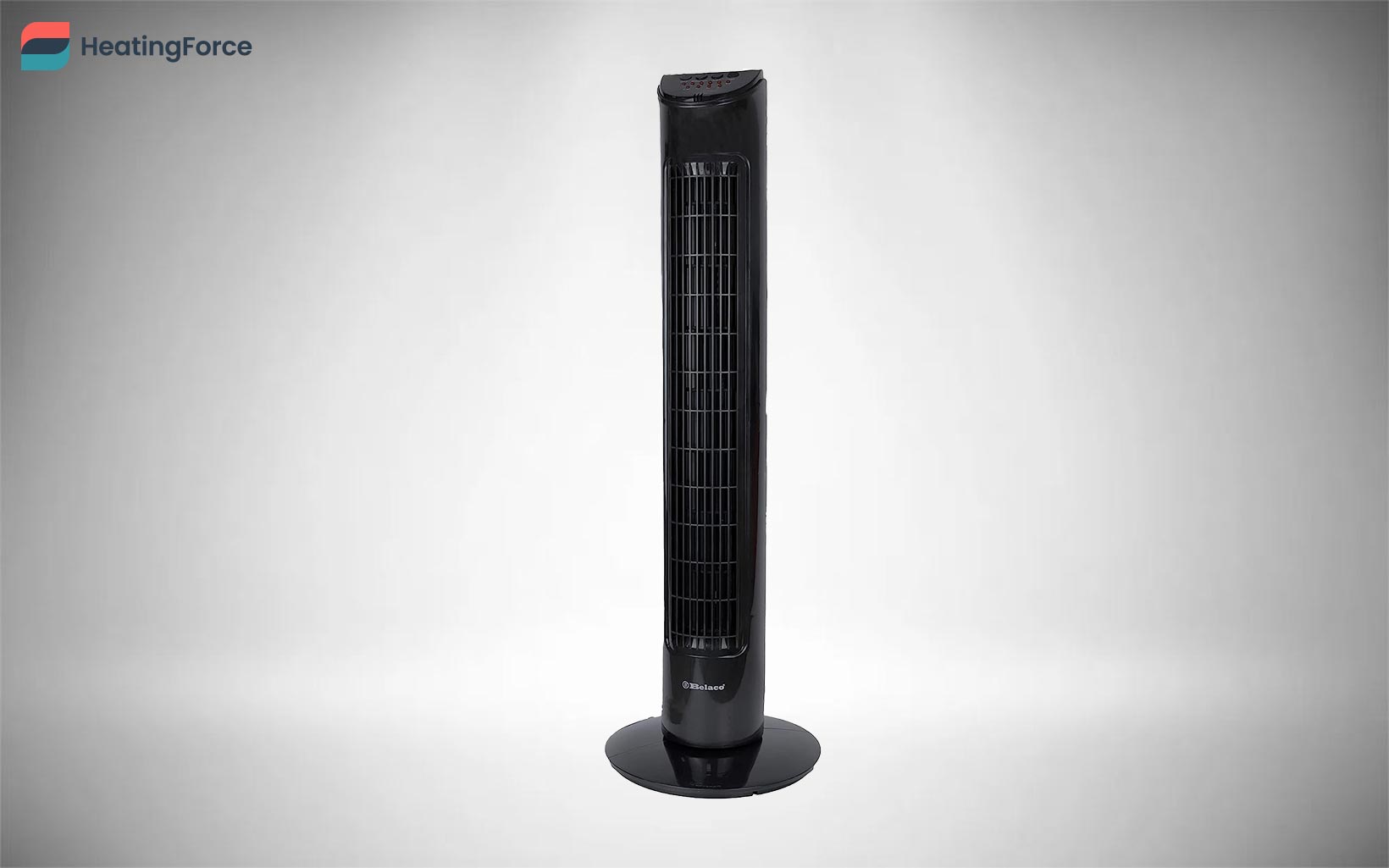
The Belaco Tower Fan is an affordable and durable medium-sized tower fan that offers enough customization to meet most families’ needs. A key benefit of the Belaco Tower Fan is that it’s made from high-durability ABS plastic to reduce the risk of damage.
The Belaco has three speed settings, the highest of which generates an airflow of 1,200 cubic feet per minute. The fan’s 85-degree oscillating head distributes the airflow evenly in a room. The unit comes with a 7.5-hour timer, so you have the ability to program a shut-off time before going to bed. The fan is designed to produce only 40 decibels of noise, which makes it an ideal option for the bedroom.
Other relevant features include intuitive in-unit controls and remote control.
The below table offers an overview of the costs involved in buying and running a Belaco tower fan.
| Belaco Tower Fan | |
|---|---|
| Purchase cost | £30-£50 |
| Power consumption | 0.04kwh |
| Running cost per hour | £0.01-£0.03 |
| Running cost per month* | £2.75 – £5.67 |
*Monthly usage costs are based on 6 hours of daily use.
Netta Tower Fan
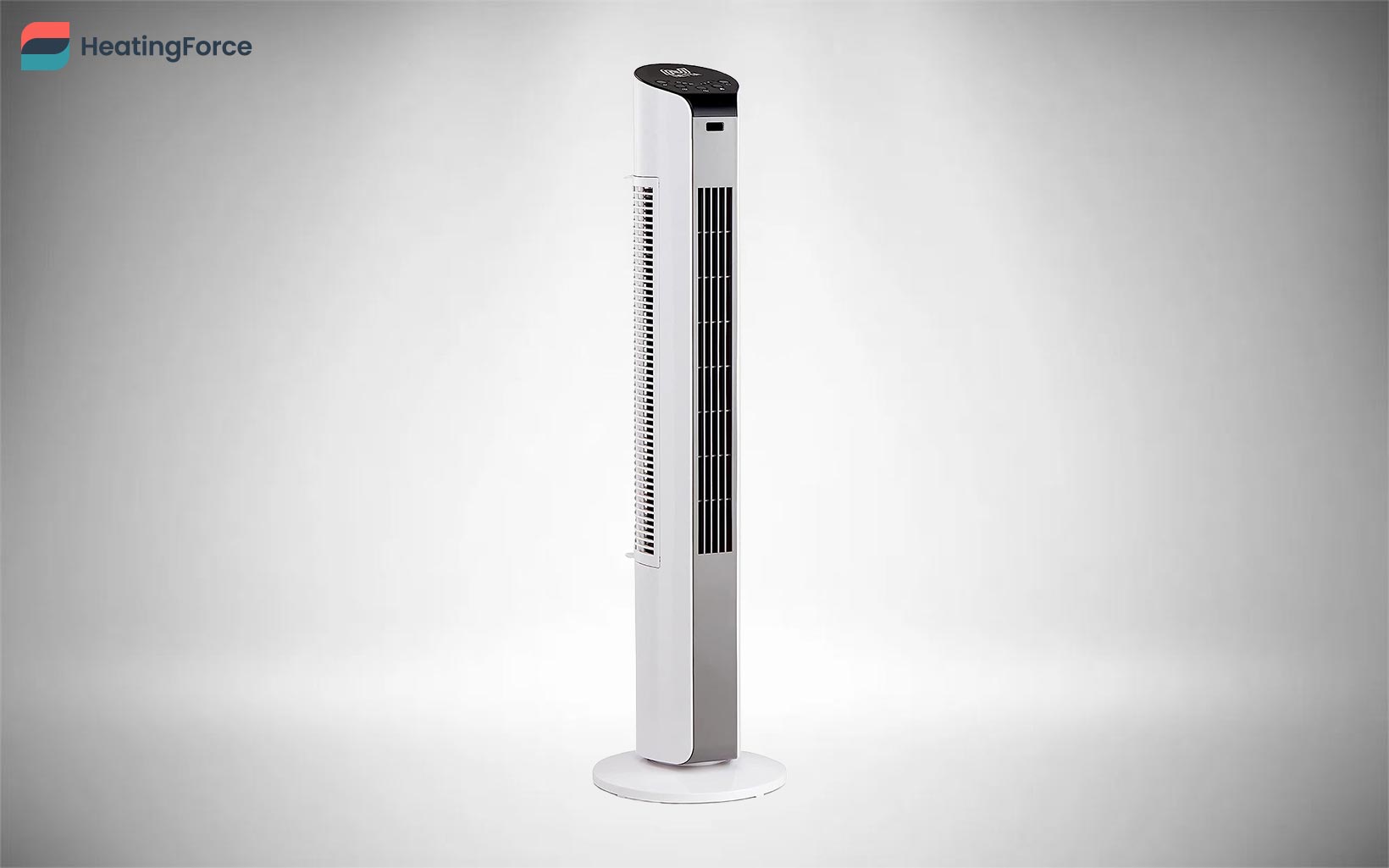
The Netta Tower Fan is a medium-sized, mid-range, no-frills tower fan that comes with remote control and a one-year manufacturer’s warranty.
Key features of the Netta Tower fan include three speeds, a 7-hour timer, and a user-friendly control panel on the unit itself. The Netta Tower fan also comes with a remote control, making it easy to adjust its settings from your sofa.
The Netta produces 54 decibels of noise, which is around the volume of a normal conversation and in line with the average tower fan noise level.
The table below lists the approximate purchase and operation costs of a Netta tower fan.
| Netta Tower Fan | |
|---|---|
| Purchase cost | £45-£65 |
| Power consumption | 0.03kwh |
| Running cost per hour | £0.01-£0.03 |
| Running cost per month* | £2.14 – £4.41 |
*Monthly usage costs are based on 6 hours of daily use.
Dreo Nomad One Tower Fan

The Dreo Nomad One Tower Fan is a premium fan that includes a remote control and comes with a smart speaker and smartphone connectivity.
A Dreo Nomad One Tower Fan has 4 speed settings, air cooler functionality, and an 8-hour auto-off timer. The Dreo Nomad One offers four modes of operation – normal, standard, sleep, and auto, affording you greater control over your fan.
Dreo designed their fan for easy cleaning with a removable rear grille and impeller wheel. The Nomad One is also one of the safest tower fans on the market, with a fused plug and built-in circuit protection. The unit bears a UK Conformity Assessed (UKCA) mark.
One advantage of the Netta Tower is that it runs quietly, at just 34 decibels. 34 decibels is around the volume of rustling leaves or whispered conversation.
The below table offers an approximate guide to the costs involved in buying and running a Dreco Nomad One tower fan.
| Dreco Nomad One | |
|---|---|
| Purchase cost | £70-£90 |
| Power consumption | 0.04kwh |
| Running cost per hour | £0.01-£0.03 |
| Running cost per month* | £2.57 – £5.29 |
*Monthly usage costs are based on 6 hours of daily use.
Are tower fans better than regular fans?
Yes, tower fans are better than regular fans. Tower fans offer more features, often double as heating or cooling units, and provide a steadier, more powerful flow of air.
There are advantages and disadvantages to choosing either tower fans or regular fans, however. The right choice for you will depend on your unique situation and what you want to get out of a household fan. Take a look at the major pros and cons of tower fans below to help inform your choice.
The five advantages of tower fans are listed below.
- Features: Tower fans often come with more advanced features than regular fans. Common features include speed settings, noise settings, and timers to allow you to customise your fan’s activity. Most regular fans will just have some speed settings and a rotate option.
- Heater/Cooler: Some tower fans double as heaters, coolers, or air purifiers. These combinations are most common with premium tower fans but aren’t available for regular fans.
- Airflow: Tower fans produce a constant stream of airflow along their entire length. Tower fans are better suited for cooling down larger spaces and providing overall greater airflow.
- Size: Tower fans take up less space than regular fans because their slim design has a smaller footprint and a slight profile along the entire length of the unit.
- Design: Tower fans are a clear winner in terms of design and aesthetics. Tower fans have a modern, sleek look that fits in well with a well-designed home, whereas regular fans look bulky and outdated.
The three disadvantages of tower fans compared to regular fans are as follows.
- Mobility: Tower fans normally only rotate, whereas regular fans often adjust across three axes, up/down, left/right, and rotationally. This gives you more directional control than a regular fan.
- Price: Tower fans are a little more expensive than regular fans. This distinction depends mostly on the brand and model that you buy. Most well-made regular fans will cost £25 – £60, while a well-made tower fan costs £40 – £90. So there is a lot of overlap in price depending on which specific fan you buy in each category. Dyson tower fans belong in a price category of their own, so it isn’t fair to include them in the comparison.
- Positioning: Regular fans fit anywhere in the room. Even when positioned behind other furniture, they still produce a full breeze because the entire fan unit is located at the very top of the pedestal.
- Unable to cool a space: Tower fans (like all fans) are unable to actually cool a space the way an air conditioner does.
Tower fans work by generating airflow from an impeller fan in the base of the unit. The fan then pushes air up a vertical shaft that directs the air towards you in an evenly distributed stream. Tower fans look like they don’t have a fan, especially Dyson units that appear to have no mechanisms at all, but they do.
The base of a tower fan houses an impeller fan. An impeller fan is a type of fan that has overlapping curved blades. Impeller fans generate a more gentle, constant airflow than the dispersion blades used in common household fans. The impeller fan pushes a steady stream of air up the vertical shaft of your tower fan.
This vertical stream of air builds up pressure in the tower fan’s shaft, which is released by a series of valves running along the length of the tower fan. These valves help to ensure that a steady stream of air is released along the entire length of the fan.
How much electricity do tower fans use?
Tower fans use between .02 – .05 kW of electricity per hour or 20 – 50 watts per hour. 20-50 watts of electricity is a fairly limited usage that won’t make a meaningful dent in your monthly electricity bill. However, some tower fans have additional functionality that consumes a lot more energy. A tower fan that doubles as a heater consumes as much as 2,000 watts of energy an hour when you turn the heating function on.
How much does a tower fan cost to run?
A tower fan costs 1-4p to run for an hour and £1.8 – £9 to run for 6 hours a day for a month. Most tower fans will consume 20 – 50 watts of electricity an hour, depending on the model. We calculated the hourly cost of running a tower fan by taking into consideration electricity rates of 34p – 70 per kilowatt hour.
How to clean a tower fan?
You clean a tower fan by taking the following four steps.
- Vacuum the vents: Use a vacuum with a brush attachment to clean out the vents on your tower fan.
- Vacuum the fan blades: You will need to unscrew the base of your tower fan to access the fan blades. Then, you repeat the same process and use a vacuum with a brush attachment to clean out your fan’s blades.
- Run the fan: You will need to reattach your tower fan’s exterior casing before completing this step. Running your fan after dusting the vents and blades dislodges any remaining dust that you have loosened with your vacuum.
- Wipe down: The final step is to clean your fan’s exterior, removing any fingerprints or accumulated dust.
What are the alternatives to a tower fan?
The alternatives to a tower fan are ceiling fans, neck fans, desk fans, and pedestal fans. Ceiling fans often come installed in your home and are a great option for circulating air around a large space. The downside of ceiling fans is their high installation costs. Neck fans are good for keeping you cool on the go but are not a solution for cooling a shared space. Desk fans are similarly portable and inexpensive but again do not perform well when cooling multiple people. Pedestal fans are the closest type of fan to tower fans. Pedestal fans have a similar level of power and circulation as tower fans and a lower price point.
Ceiling fans
A ceiling fan is a ceiling-mounted fan with rotating blades mounted on a central hub. The ceiling fan is commonly mounted in rooms as a way to circulate air around an entire living space. Ceiling fans do not offer any ability to target the flow of air towards one specific person or area. Ceiling fans are also expensive to install as they need to be integrated into your home’s wiring and permanently mounted to the ceiling.
There are two advantages to choosing ceiling fans over tower fans. Firstly, ceiling fans offer better air circulation across an entire room due to their location on the ceiling. Secondly, ceiling fans are generally more powerful than tower fans and move more air in total because they have longer blades.
There are three disadvantages to choosing ceiling fans over tower fans. First, ceiling fans are expensive to install. Ceiling fans need to be wired into your home electronics and permanently fixed to your ceiling. This process is expensive if you don’t already have ceiling fans in your home. Second, ceiling fans cannot be focused on a specific individual. Ceiling fans circulate air around the whole room, which makes them less well-suited for cooling down one person working at a desk. Third, ceiling fans cannot be moved. The portability of tower fans means you have the ability to reposition them wherever you need them, making tower fans a versatile cooling solution. Ceiling fans are fixed in place, so they are only be used in the room in which they are installed.
Neck fans
Neck fans are small fans that are mounted to a frame that hangs from your neck. The goal of a neck fan is to offer highly targeted airflow that you take with you.
There are three advantages of neck fans over tower fans. Firstly, neck fans go anywhere you go. Neck fans are wearable around your neck, and so you keep yourself cool no matter where you are. Secondly, neck fans are cheap compared to tower fans. You get a neck fan on Amazon for £10 – £30, whereas tower fans cost in the £60 – £100 range. Finally, neck fans are highly targeted. You keep yourself cool with a small amount of electricity.
There are three disadvantages to choosing neck fans over tower fans. Firstly, neck fans only cool one person. Neck fans aren’t going to be much use if you want anything more than the wearer. Secondly, neck fans draw some strange looks. Most people don’t walk around with a fan hanging from their neck. You need to be ready for some potentially unwanted attention. Finally, neck fans only blow air on your face. A breeze on your face is often enough to keep you cool on less hot days. However, neck fans might not be enough on the hottest days.
Desk fans
Desk fans are small, table-standing fans that offer targeted cooling to a specific person. Some table fans are like small pedestal fans with a normal electric outlet input. Other fans are smaller, USB-powered fans that connect to your laptop. Desk fans are typically affordable alternatives to pedestal fans.
There are two advantages of choosing a desk fan over a tower fan. First, a desk fan is cheaper than a tower fan. A decent desk fan costs between £10 – £20, whereas a tower fan will cost you £60 – £100. Second, a desk fan is very portable. Most desk fans are just a couple of inches tall and are often powered via a USB cable. Those features make it easy to take a desk fan on your commute or wherever you want to go. Tower fans are easy to move from room to room but can’t leave the house with you.
There are three disadvantages of desk fans compared to tower fans. First, desk fans have fewer settings than tower fans. Tower fans often have different speeds and modes that allow you to personalise your cooling experience. Many tower fans have a sleep mode that reduces noise while you sleep. Desk fans do not generally have these features. Second, desk fans cannot circulate air around a room. Desk fans are highly targeted and only cool one or two people at once. Third, desk fans are less powerful than tower fans. Desk fans are small and use less power than tower fans. However, they just can’t generate as much airflow as a tower fan.
Pedestal fans
Pedestal fans are the most recognizable type of fan. Pedestals have a rotating hub of blades mounted on top of a tower. All pedestal fans are most similar to tower fans but with the blades themselves directly facing you. Pedestal fans often have a rotation option and several speed settings. Pedestal fans are adjustable to cool a specific person or to oscillate and cool an entire room.
There are two advantages to choosing pedestal fans over tower fans. First, pedestal fans are generally cheaper than tower fans. Most pedestal fans cost £30 – £60 while most tower fans cost £60 – £100. Second, pedestal fans are easier to target specific people or spaces. A tower fan rotates left or right but cannot change the angle of its airflow vertically. A pedestal fan gives you more options to adjust the direction of the fan itself.
There are four disadvantages to choosing pedestal fans over tower fans. First, pedestal fans have a less modern, appealing design. Tower fans integrate well into even the most stylish homes with a sleek design. Second, tower fans offer more settings and advanced features. Tower fans commonly have a sleep mode that reduces noise during the night. Some tower fans even come with smart speaker integration. Pedestal fans rarely have these features.
Third, tower fans offer a steadier stream of airflow. The blades on pedestal fans chop the air towards you, creating a buffetting sensation in front of them. Tower fans provide constant, steady airflow that is a lot more pleasant. Fourth and finally, tower fans are more economical with space than pedestal fans. Pedestal fans often have a larger footprint than tower fans. Also, the large blades make them difficult to position in tight spaces.
